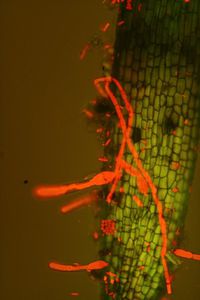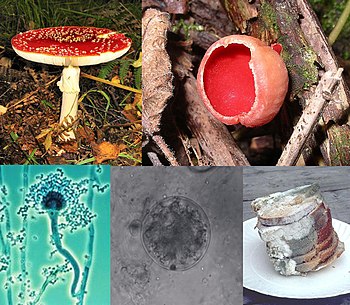Micro-organisms in the soil
- * Topic in Gardening courses
- * This page is under construction. If you have any ideas to contribute to this page, place a comment below in the Comments section. --JE 01:53, 14 June 2012 (PDT)
Provided there is a carbon source, microorganisms exist in large numbers in the soil. There are more microbes in a teaspoon of soil than there are people on the earth. For example, there are 100 million to a billion bacteria in one gram of soil and 100,000 to a million fungi. Their biomass per m2 is for bacteria 40-500 g and for fungi 100-1500g at 0–6 inches (0–15 cm) depth of soil.[1]
Most of the soil microbes tend to be in a dormant state, the more so in tilled soils. Soils that haven't been tilled for a longer time have significantly greater levels of microbes. What microbes need as food are dead plant residues and plant nutrients.
Soils contain soil organic matter. Soil organic matter is composed of:
- living microorganisms,
- dead residues of plant and animal material,
- and the organic material that is resistant to decomposition and that may be thousands of years old (which we call 'humus.')
Microorganisms need regular supplies of new organic material in order to survive.
Microbes grow faster in warmer temperatures. This is why in the tropics we find little or no humus in the soil. Most of the carbon is tied up in above-ground vegetation. In regions with high temperatures and enough moisture, microbes quickly decompose soil organic matter. In colder regions soils contain much larger amounts of soil organic matter.
In acid soils microbes are less effective in decomposing organic material. This is why liming soils often enhances decomposition and more nutrients for plants become available.
Organic material that has been made finer will more easily be decomposed by microbes because the surface area is bigger for finer particles.
Grassland generally forms much organic material in the soil because 50 percent of the grass roots dies each year. This is why agricultural soils of former prairies with thick layers of humus formed in the past are very productive. These soils also contain more microbes and larger fungal populations.
Rhizosphere
The rhizosphere is the narrow region of soil that is directly influenced by root secretions and associated soil microorganisms. The rhizosphere typically contains 1000 to 2000 more microorganisms than soil without roots.
"The rhizosphere contains many bacteria that feed on sloughed-off plant cells, termed rhizodeposition, and the proteins and sugars released by roots. Protozoa and nematodes that graze on bacteria are also more abundant in the rhizosphere. Thus, much of the nutrient cycling and disease suppression needed by plants occurs immediately adjacent to roots."[2]
List
- Azotobacter, see Azotobacter - Wikipedia
- Cyanobacteria, see Cyanobacteria - Wikipedia
- Protozoa - Protozoa are single-celled eukaryotes (organisms whose cells have nuclei) that commonly show characteristics usually associated with animals, most notably mobility and heterotrophy.
- Rotifers
- Roundworms
Bacteria
Bacteria exist in large numbers in the soil. Because their size is small they have a rather small biomass compared to other soil microorganisms.
Aerobic and anaerobic bacteria
Bacteria that need oxygen for their survival are called aerobic bacteria and bacteria that do not require oxygen for survival are called anaerobic bacteria. Anaerobic bacteria may die if kept in an oxygenated environment. They can be found deeper into the soil, inside soil particles and also deep in the ocean.
The differentiation between aerobic and anaerobic bacteria is important for how we treat the soil. Aerobic bacteria live closer to the surface and anaerobic bacteria deeper. In general when we cultivate a soil it is preferable to not disturb the soil layers too much and keep above what's up and keep down what's below. This is why most organic gardeners don't plow or dig a soil but don't cultivate it all (only cover the soil with mulch) or cultivate it with a pin similar to how plowing was done in the ancient past.
The nitrogen cycle
- Main article: Nitrogen cycle. See also Some science for the gardener, section Nitrogen cycle.
Mention only the involved bacteria here.
Actinobacteria
See Actinobacteria - Wikipedia Actinobacteria or actinomycetes appear 10 times smaller in number in soils compared to bacteria but because their are larger in size, their total biomass is similar.
Rhizobium

Rhizobia, see Rhizobia - Wikipedia
Fungi include microorganisms such as yeasts and molds as well as mushrooms. Although fungi are smaller in population numbers, they dominate the soil biomass in undisturbed soils. Bacteria, actinomycetes and protozoa can tolerate more soil disturbance and therefore dominate in tilled soils. Fungal populations tend to dominate in untilled soils.
Normally we see little or nothing of fungi except when they form fruits such as mushrooms and molds. Fungi play an essential role in nutrient cycling and exchange. They are used directly as source of food, such as truffles and edible mushrooms. They can be a leavening agent for bread and are used to ferment wine, beer, soy sauce. Fungi have also been used for the production of antibiotics. These antibiotics grow naturally in healthy soils, see the section below 'Penicillium.'
Mycorrhizae
- Main article: Mycorrhiza
Penicillium
Yeasts
Molds
Algae
Protozoa
Nematodes
Nematodes, like fungi, are more present in untilled than in tilled soils.
See also
References
- ↑ [http://ohioline.osu.edu/sag-fact/pdf/0016.pdf Understanding Soil Microbes and Nutrient Recycling - The Ohio State University}
- ↑ Rhizosphere - Wikipedia
External links
- BENEFICIAL AND EFFECTIVE MICROORGANISMS FOR A SUSTAINABLE AGRICULTURE AND ENVIRONMENT Dr. Teruo Higa and Dr. James F. Parr, Japan 1994 (EM - Effective Micro-organisms)
- Cyanobacteria Wikipedia
- Mycorrhiza Wikipedia
- Rhizobia Wikipedia
- Root nodule Wikipedia
- Soil biomantle Wikipedia
- Soil life Wikipedia
- The role of soil bacteria The Ohio State University
- Understanding Soil Microbes and Nutrient Recycling The Ohio State University
Videos
Books
- Soil microbiology (1952) Author: Waksman, Selman A. (Selman Abraham), 1888-1973; 380 pages



